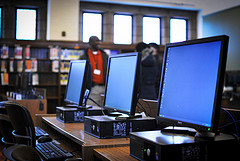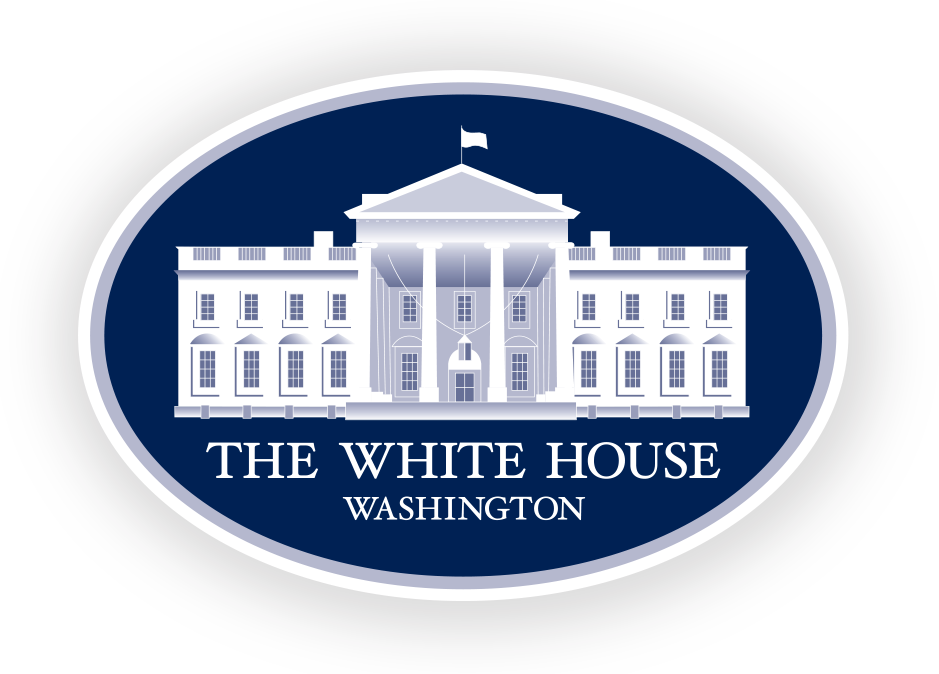
Fast, affordable Internet access for all.

Community anchor institutions play a critical role in bridging the digital divide. These networks that connect government buildings, libraries, and schools are often called “institutional networks” or “I-Nets.” Since the start of MuniNetworks.org, we have noted the ways these institutions have expanded services and saved money. Now, these stories have been compiled into one quick-reference resource.
As franchise agreements run out with incumbent service providers, public institutions often struggle to renegotiate contracts at sustainable prices. Other communities have been left behind altogether by large cable and telephone companies and cannot get the high quality Internet access needed for their libraries or schools.
With 30% of U.S. households without a broadband connection at home, schools and libraries are portals to digital learning tools, social services, and job applications. A local government self-provisioning a fiber network to connect these facilities is often the most cost-effective way to ensure these essential entities have affordable and reliable Internet access.
In this page, we detail the many times schools and libraries have used municipal networks to save money, increase Internet access, and provide better services. We also note how these municipal institutional networks can be incrementally expanded beyond institutions to businesses and homes, creating city-wide connectivity. Check out the page.

Community Anchor Institutions, such as public libraries and schools, are among the first places people go to access the Internet when they cannot access it at home. With 30% of the United States without a broadband connection at home, libraries and schools are essential for access to social services, job applications, and digital learning tools. These institutions, however, may not themselves have the capacity to meet the increasing demand for Internet access.
That can be a really big problem. With many states requiring online testing, schools need to have adequate bandwidth, so that networks do not crash at key moments. Some schools have to ration Internet access - while some students are testing, no one else is allowed to use the Internet. This means no video-streaming educational videos or remote learning classes while testing takes place. Educational opportunities shrink as students and teachers have to forego the most up-to-date online resources because of this bandwidth shortage.
The major barriers to high quality Internet access for community anchor institutions are cost and availability. National carriers like AT&T often do not provide the needed capacity at affordable rates. Municipal networks, however, are locally controlled and attuned to local needs. They treat community anchor institutions like a fundamental building block of society, not a profit center to be exploited.
72.2% of libraries help patrons access employment databases, and 58.8% of libraries face budget constraints when increasing their bandwidth.
63% of schools do not meet the ConnectED Current Goals for high speed connectivity which impacts nearly 40 million students in grades K-12.
-- Education SuperHighway’s Connecting America’s Students: Opportunities for Action
The federal E-rate program provides more than $2 billion in funding each year to support Internet access at public schools and libraries. The E-rate program, however, does not go far enough in helping these entities achieve high-capacity, reliable, and affordable Internet access. In too many cases, E-rate simply helps schools and libraries to afford connections priced at exorbitant levels from national carriers. Below, we detail the many benefits of local governments connecting their own community anchor institutions with self-provisioned networks - often called “institutional networks” or "I-Nets".
Learn more
Keep up to date with all things community broadband by subscribing to a once-per-week email with stories about community broadband networks.
Internet access is already crucial for community anchor institutions and will only become more important as society continues to incorporate technological advances into every aspect of life. Self-provisioning often results in higher capacity connections that are more reliable, and most importantly for local budgets, much more predictable in terms of future costs. Operating an institutional network, communities can plan years in advance for upgrades and have greater security in long term budgeting rather than worrying about the incumbent provider raising rates.
For example, Martin County in Florida had been leasing lines from Comcast to connect the schools and public buildings, but its 10-year franchise agreement was about to expire. With Comcast demanding a stunning price increase, Martin County instead built an underground fiber network with much more redundancy than Comcast offered. Compared to leasing lines, Martin County expects to save an estimated $30 million over the next twenty years. Now Martin County does not fear rate hikes or unexpected outages from Comcast’s network.
In talking with some schools that have transitioned from leased lines to operating their own network, some have reported that network management requires less staff time because the modern technology behind a wide-area network largely runs itself. If something goes wrong, staff have the information they need to diagnose and repair rather than having to wait on hold for a CenturyLink call center to begin investigating a problem.
This chart of five different school districts across the U.S shows some of the savings schools have experienced with municipal networks. The orange is the original provider’s exorbitant price for each Mbps per month. The blue is the price from the municipal network. The savings are stunning.

Sources for the graph
MuniNetworks Public Savings Fact Sheet and Breaking the Broadband Monopoly
For more information about costs and savings, dig into these examples of savings to community anchor institutions:
Ammon, Idaho: municipal network lowers prices, increases capacity for schools after State Education Network dispute with CenturyLink disrupts service.
Ottawa, Kansas: the schools save $3,000 a month and get double the bandwidth.
Staunton, Virginia: the schools used to pay $2,000 a month just to lease fiber, but now they’re connected for free.
Increased Capacity, Expanded Services
Libraries and schools have used the increased Internet capacity of some municipal networks to expand services and enhance their educational materials. Rural districts can use remote instruction via video-streaming to offer more foreign language and science classes. Communities have crafted innovative programs for students to explore how high-speed Internet access can be used in the classroom for more individualized and self-paced learning. These educational experiences cannot be achieved without high-capacity Internet access.

Southwest Georgia: some schools are leveraging the better Internet access to bring STEM education, such as live interactive science demonstrations, to students in rural classrooms.
Chattanooga, Tennessee: the public library has dedicated an entire floor as a maker space, encouraging entrepreneurship and the latest technological innovations.

Expansion Beyond Institutional Networks
One of the many benefits of institutional networks is that communities can use the assets and knowledge from building those connections for economic development and other policy goals. For instance, when building the fiber to connect schools and libraries, smart communities install extra fiber that can be used to connect local businesses or form the backbone of a citywide network in the future if that becomes feasible. Many local governments have found that after building a high-speed institutional network, local businesses clamor for access as well.
Santa Monica is a great example of a community that started by self-provisioning community anchor institutions and has gone on to create many benefits for businesses and residents with both the savings and assets from the municipal network.
Without incurring any debt, the city built an expansive fiber network. They started by connecting municipal buildings and community anchor institutions with a $530,000 investment. Then, they expanded the network through grants for intelligent traffic systems and the savings from discontinuing expensive leased lines.
The city saved $400,000 the first year and $700,000 each subsequent year. With the extra fiber, Santa Monica provides better Internet access to local businesses and leases fiber to other service providers. The money from the municipal network is reinvested in the community, encouraging economic development. See our case study for more details.
To learn more about the benefits of community networks providing Internet access to libraries and schools, check out our multimedia resources.
Community Broadband Bits Podcasts
These podcasts aim to be around 20 minutes long and feature issues related to libraries and schools.
| Episode | Title | Synopsis | Guests | Transcript |
| 79 | Don Means on Libraries and White Spaces | Explanation on TV white spaces wireless technology | Don Means | Transcript 79 |
| 71 | Education SuperHighway Wants Better Broadband for Schools | Education SuperHighway's approach to ensure better Internet connection to all schools and the role of community to achieve this goal | Evan Marwell | Transcript 71 |
| 46 | North Georgia School Brings Gig To Schools, Jobs to Region | The origin of the North Georgia Network and its economic and social impact on the region | Paul Belk | Transcript 46 |
| 43 | Carroll County Explains Many Benefits of County Owned Fiber | How Carroll County Public Network started and the benefit its community network provides | Gary Davis | Transcript 43 |
| 39 | Moultrie City Manager Discusses Origins of CNS Network in Georgia | The origin of CNS network in Georgia and the benefits of the network for local schools and community savings | Mike Scott | Transcript 39 |
Conferences, presentations, hearings, and other research
Looking for even more information about libraries, schools, and Internet access? Here are archives of conferences, presentations, hearings, and other research.

Community-Based Broadband Solutions Report PDF January 2015 The Executive Office of the President
The White House report features the savings to schools and libraries provided by locally controlled community networks.

Connecting America’s Students: Opportunities for Action Report PDF April 2014 Education SuperHighway
This report examines E-rate spending and underscores the importance of Internet access in schools. The report attempts to answer why the connectivity gap persists and provide solutions to increase Internet access.

2013 Digital Inclusion Survey of Libraries digitalinclusion.umd.edu From the University of Maryland Funded by the Institute of Museum and Library Services
Each year, the University of Maryland releases a survey of digital information services that libraries across the U.S. offer. The reports highlight inequities in Internet access and the changing role of libraries.

Connected Communities in an Age of Digital Learning: a Vision for a 21st Century E-rate Program Video Archive February 27, 2014 New America Foundation
This webcast concerned the modernization of the E-rate program and increasing Internet access at libraries and schools. Featured speakers included representatives from the Institute of Museum and Library Services, the U.S. Department of Education, New America’s Open Technology Institute, the Albemarle County (VA) Public Schools, and the Richland Library (SC).

Schools, Health & Libraries Broadband (SHLB) Coalition www.shlb.org
The SHLB is a nonprofit organization formed in 2009 to support affordable, high-capacity broadband at anchor institutions. They develop and promote policies and programs that further connectivity in communities.

National Association of Telecommunications Officers and Advisors (NATOA) www.natoa.org
A professional association of telecommunications officers and advisors that deal with communication policies and programs in local governments.
Photo of library computers courtesy of the Knight Foundation
Photo of library headquarters from the public domain
Winston-Salem struck up a smart deal with the North Carolina Department of Transportation in 2011. Four years later, that agreement allows the city to move forward with its vision for an I-Net.
The Winston-Salem Journal reports that the City Council recently approved $826,522 for networking equipment to light up city owned fiber installed by the NCDOT. The agency has been upgrading area traffic control systems, a project estimated at around $20 million. Winston-Salem took advantage of the opportunity and paid the agency $1.5 million to simultaneously install its own fiber in the state conduit.
“The city was able to have the network built at only the cost of the fiber,” [city information systems department Chief Officer Dennis] Newman said. “They (state traffic contractors) are running fiber optic cable all around the city to where all the traffic lights are at. This will enable us to connect to all facilities all over the city – fire stations, public safety centers, satellite police stations – right now there are about 40 locations that we have targeted to connect to.”
As is typically the case, Winston-Salem currently pays private providers for connections at each facility but when the new I-Net is up and running, they will be able to eliminate that expense. The new voice and high-speed network will outperform current connections, described in the article as "out-of-date." City officials also told the Journal that some municipal offices have no Internet access at all but will be connected to the new I-Net.
A number of other communities have taken advantage of partnerships with state and federal transportation agencies during traffic signal upgrades. Martin County, Florida; Aurora, Illinois; and Arlington, Virginia saved considerably by collaborating during similar projects.

When Steamboat Springs resolved to improve Internet access for key community anchor institutions and businesses, they decided to make an economical investment in a carrier neutral facility to allow multiple ISPs to invest and compete with each other. In episode 163 of the Community Broadband Bits Podcast, Tim Miles explains what that means and how they did it. Tim is the Technology Director at Steamboat Springs and South Routt School Districts in Colorado.
He tells us about the poor connectivity the community had from CenturyLink and how they opened a bottleneck to encourage more investment. In part because of how Colorado limits local authority to build networks, they formed the Northwest Colorado Broadband Cooperative with the local Chamber of Commerce. They are already seeing benefits in the form of lower prices for anchor institutions and reduced outages - Tim describes just how painful those outages had been when there was no local Internet choice.
This show is 20 minutes long and can be played on this page or via Apple Podcasts or the tool of your choice using this feed.
Transcript below.
We want your feedback and suggestions for the show-please e-mail us or leave a comment below.
Listen to other episodes here or view all episodes in our index. See other podcasts from the Institute for Local Self-Reliance here.
Thanks to bkfm-b-side for the music, licensed using Creative Commons. The song is "Raise Your Hands."
Storm Lake’s city council recently approved a resolution to collaborate with other entities in Buena Vista County to install a fiber optic network. For this fiber project, the city, school district, and county have forged a partnership to share the costs and reap the benefits of the estimated $1,374,335 project.
As the county seat, the city has 10,600 residents, a waterpark, a college, and a small school district of 2,442. The project’s origins started with an effort to improve water and wastewater communication. In exploring their options, the city decided fiber would replace the wireless radios. The fiber will also provide more reliable and secure communications for the government and school facilities.
City leaders estimated the cost only for a contract to lay a system of ducts for the fiber. They will also consider trenchless methods of distributing the fiber throughout the city. The cost estimate does not include the hardware needed to connect the fiber at each school and government facility in Storm Lake. The city intends to purchase the fiber in a separate contract in order to minimize costs and ensure quality.
The City Clerk Yarosevich has said that they expect the base project to be completed this year with the currently available funds of $700,000-$800,000. The base project has five possible expansions to be completed with additional funding. Construction on the base project is expected to be mostly finished by December 18th 2015.
The collaboration between the City of Storm Lake, Buena Vista County, and the Storm Lake Community School District is anticipated to bring savings to the community. The $1.4 million cost will be split among the three agencies, and the network itself is expected to reduce costs for internet, phone, and hardware. By creating the network themselves, they intend to ensure collaboration in the future and save on costs. From the June 1st City Council meeting agenda item:
Changes in leadership in Chanute have put the community's FTTH plan in suspended animation. In April, the City Commission decided to delay financing shortly before the scheduled bond sale. It is unfortunate that residents and businesses will lose the opportunities the fiber deployment would bring. Nevertheless, they deserve the right to make their own choices, good or bad.
The community of Chanute deployed a network incrementally with no borrowing or bonding in order to improve efficiencies, save public dollars, and control connectivity for municipal facilities. Local schools and colleges, struggling to compete, began taking advantage of technology in the classroom and expanded distance learning. The network eventually created a number of economic development opportunities when community leaders started providing better connectivity to local businesses. We told Chanute's story in our 2013 report "Chanute's Gig: One Rural Kansas Community's Tradition of Innovation Led to a Gigabit and Ubiquitous Wireless Coverage."
Chanute made history when it was the first municipality in Kansas to obtain permission from the Kansas Corporation Commission to issue bonds for the project. They also became the first municipality in the state to seek and receive "eligible telecommunications carrier" (ETC) status. Chanute was awarded over $500,000 in Rural Broadband Experiment Funds from the FCC. Whether or not they will still be able to take advantage of those funds remains a question. After taking action and putting so many of the necessary pieces in place, it is disheartening to see the plan abandoned by politicians.
Regardless of the future of the FTTH project, Chanute has the infrastructure in place to encourage more economic development, connect community anchor institutions, and allow the community to control its own costs. The FTTH project is still a possibility.
According to eSchoolNews, Consolidated Electric Cooperative will provide 15 school districts with gigabit connectivity. The school districts will then have greater access to online resources and be better able to comply with mandated online testing in Ohio. In the article, Doug Payauys, vice-president of information systems for Consolidated Electric Cooperative, described the need for improved Internet access in schools:
"Technology is creating a shift in today’s classroom, and it’s transforming the way teachers educate and students learn. As the country becomes a more digital-based society, schools must work to transform lesson plans and accommodate new technologies”
The gigabit broadband will also improve the Wi-Fi in the school districts, providing more bandwidth for wireless learning devices. Wireless connections almost always depend on wireline backhaul to ensure each access point does not have a bottleneck between the user and the larger Internet. With better Wi-Fi, the schools hope to support an online curriculum for students to learn at their own pace.
Consolidated Electric Cooperative also intends to offer the gigabit connectivity to local businesses. They already offer some broadband connections to businesses through their Enlite Fiber Optic Network. They first began to develop this network in 2010 with some costs covered through the Broadband Initiatives Program created by the stimulus effort. Since then, they have expanded the network which now consists of 200 miles of fiber optic cable from Columbus to Mansfield, spanning five rural counties in North Central Ohio.
In a recent Boston Globe Opinion, Dante Ramos notes that Boston has a reputation as a technology hub. When seeking options and affordability, however, Ramos recounts the successful approach of Lafayette, Louisiana:
Today, the top broadband speeds advertised to residential customers in Boston are about one-ninth of what’s available in Lafayette. A municipal network in Boston isn’t inconceivable; the fiber-optic network now connecting scores of government facilities could theoretically become the spine of a citywide system.
Ramos acknowledges the challenges Boston would face if it were to take up such a project, but he also notes that it was no small feat for Lafayette. The economic development gains have more than justified the investment:
Half a decade later, though, the benefits have come into view. A company serving an active Louisiana film industry can use the Lafayette network to transmit massive quantities of digital footage. Employees of a major jewelry manufacturer in town can get medical advice remotely without having to go in and out of a highly secure plant. And the presence of the network is shaping investment decisions in subtle ways.
Ramos shares the story of his encounter with the owner of a local Internet consulting firm who chose the company data center location because it was within the LUS Fiber service area. He also valued the network's speed, reliability, and quality customer service.
Lafayette's network has also continually drawn in new employers, including three high tech companies in the fall of 2014. Along with those approximately 1,300 well paying positions come the multiplier effect on the local economy.
Ramos' piece inspired a letter to the Globe from Art Gaylord and Dan Gallagher, Chairman of the Board of Directors and Senior Consultant respectively, from OpenCape. The two find inspiration in the story of Lafayette but lament what they see as a lack of enthusiasm in the Cape Cod region.
Decorah, named an "All-Star Community" in part due to benefits from their internal fiber network, is now exploring new ways to utilize MetroNet. According to a recent Decorah Newspapers article, the six community anchor institutions (CAIs) that collaborated to deploy the network recently met with the city council to discuss the future.
The 11-mile network began serving CAIs and an additional 18 facilities in 2013. After a 2008 flood that knocked out communications, the city, county, and school district began planning for the network. Eventually, the project grew to include Luther College, the Upper Explorerland Regional Planning Commission, and the Winneshiek Medical Center. BTOP funds paid for much of the approximate $1 million deployment but contributions from participants supplied an additional $450,000.
According to the article, MetroNet supplies each institution with its own fiber, leaving plenty to spare. Decorah City Manager and Chair of the MetroNet Board Craig Bird says that the network has a "vast amount" of dark fiber available that is not being used. Members of the community have approached the Board about using the fiber for better connectivity beyond current uses:
Bird said the MetroNet Board has to decide how to respond to a grassroots petition committee of citizens “demanding access to the MetroNet and faster broadband speeds and fiber capacities” for Internet access to private homes and businesses.
“The MetroNet Board is now starting to look at the future and what the MetroNet holds for the six anchor members, but also for the community,” he told the Councils.
At the city council meeting, Bird discussed the possibility of creating a municipal Internet utility, creating a cooperative, forming a nonprofit, or leaving MetroNet as a service for the existing members and facilities. They also considered the option of leasing dark fiber to private providers.
Bird also told the council that the MetroNet Board has agreed to participate in a regional feasibility study to include northeast Iowa. The Iowa Association of Municipal Utilities has commission the study that will include a number of towns:
Chris will travel to Syracuse, New York to speak on March 4th as part of Syracuse MetroNet's Broadband Speaker Series. If you are in the area and interested in attending, the lecture will be at 7 p.m. at Grewen Auditorium at the Le Moyne College campus. A PDF of the press release is available online.
Syracuse MetroNet serves fifteen community anchor institutions, including hospitals, educational institutions, government agencies, and community organizations. Unfortunately, the connectivity situation for businesses and residents needs a better solution.
Last fall, Syracuse Mayor Stephanie Miner expressed interest in developing a municipal network to improve connectivity in this community of 147,000. Residents now depend on Time Warner Cable for service and do not treasure the idea of dealing with an even bigger behemoth, should the merger with Comcast come to pass.